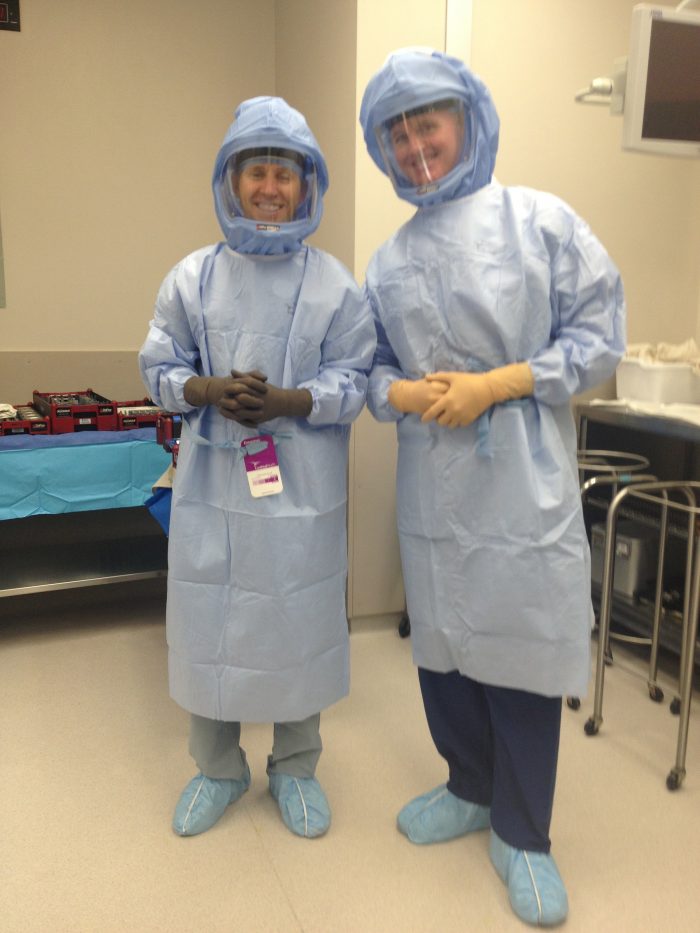(Part 2 in a series, see other posts here.)
Why Are Operating Rooms Kept So Cold?
Operating rooms have a well-deserved reputation for being cold. The journey from pre-op hold to the OR is marked by ever decreasing temperatures until finally, upon entering the OR, many patients say “Man, why is it so cold in here?”
As a person who’s been bitching about the temperature, dedicated to keeping patients warm for years, I’m going tell you what’s really going on.
Right off the bat: it’s not cold enough to prevent infections. You need refrigerator cold to slow bacterial growth and while some of us feel like it’s that cold, it’s not.
Stress Causes Body Temperatures To Rise
When you see the hero (or villain) in a movie with beads of sweat on their forehead, you know they are intensely concentrating because something important is at stake.
That’s your scrubbed in operating room crew. The sacred responsibility of “First, do no harm.” is a pretty big stressor on its own. Combine that with the factors listed below, and you’ll understand why they’re hot even though the room feels cold.
Other Heat Insults For The OR Crew Include:
- Wearing a second layer of clothes. (Sterile gown, gloves, hats, which are at least water repellant, it’s like wearing plastic.)
- Maybe a third layer of clothes. If your operation requires the use of Xray, your crew will wear a shoulder-to-knees lead apron under the sterile gown.
- If there’s a lead apron, there’s a lead thyroid shield, which is a throat-choking, lead “scarf” that velcros behind the neck. The velcro never lines up right. It’s always biting you.
- A mask, and/or hood, and/or protective glasses/face shield.
- Maybe they are wearing waterproof leg covers or overalls in addition to the sterile gown and lead.
- Standing under at least 2 very bright, very hot lights.
- Standing next to the Bair Hugger which is a device that blows warm air onto the patient. (Looks like a raft with tiny holes in it, warm air blows through the holes.)
- Standing next to other equipment that puts off heat.
- Standing uncomfortably close to other team members.
- Some people loose the ability to be nice when they are stressed, which can stress everybody else out.
- Some cases last all. day. long.
The struggle is real.
Your crew is legitimately hot even if the operating room temperature is in the lower 60’s – upper 50’s.

But, the struggle is also complicated.
Being Cold Isn’t Good For Some Patients
What anesthesia has intuitively known for years is now validated by research – hypothermia has risks – and our industry watchdogs are making sure we respond. New standards call for keeping operating rooms between 68ºF and 75ºF.
Believe me: I have been a champion of warming the room since I started anesthesia. But when I heard they said sixty-eight to seventy-five? Seventy-five?
Even I thought “When pigs fly out of a certain orifice. My people will faint.”
But they are not fainting. They are coming to grips with the change. Some actually wear cooling vests. They are rock stars.
What happens is this: We raise the room temperature at night and start the day a little warmer than we’re used to. By the end of the day, the room temp is back down. As long as the patient is warm, the standards allow for cooling the rooms. In time, the higher morning temperature will become the all-day temperature. It’s how progress works. Always the steady march towards improvement.
Rest assured, anesthesia has ways to keep you warm. We run your IV fluids through a warming device, use the aforementioned Bair hugger, and as a last resort, we secretly increase the room temperature and then deny, deny, deny when someone accuses us of doing so.
Because … First, do no harm.
Ask a question, or leave a comment below, and stay tuned for the next installment: Why Do I Have To Take Off My Underwear?






Some staff actually struggle with the cold in the OR. There is a new product from OpertaionHeatJAc which acts like a personal radiator and takes the form of a belt like garment worn over scrubs but under a warming jacket. Check it out at
https://www.operationheatjac.com/
This is awesome! I have been freezing in the OR all. my. life!
Operationheatjac products may decrease SSIs as instead of borrowing the patient’s Bair Hugger hose to keep warm and spreading dust and bacteria throughout the OR, anesthesia providers can now keep warm by wearing the heat producing belt around their torso over their scrubs and under whatever they typically wear to keep warm. The products are currently a personal use products not to be worn exposed in the OR. If they prove to reduce SSIs, perhaps hospitals will decide to make the purchases.